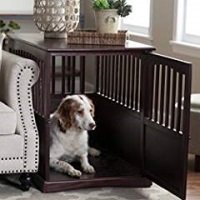Choosing the Best Dog Crate
When choosing a dog crate (sometimes referred to as a dog cage or dog kennel) for your dog, you have two important criteria to consider: size and structure. This blog post will talk about both and how to choose which dog crate will best fit your dog.
Dog Crate Size
This is the most important criteria when considering what dog crate to buy. Too small, and your dog is cramped and can barely move. Too large, and your dog might use half of it as a bathroom.
The general rule is the crate should be big enough such that your dog can stand up or sit down without its head hitting the top, and small enough such that he or she can lay down or stand up comfortably.
Labrador Training HQ suggests the crate be 2 to 4 inches taller than the dog sitting down, and 2 to 4 inches longer than the distance from its nose to the base of the tail. The width of dog crates grows in proportion to the length, so you don’t need to worry about width.
When measuring your dog, make sure it’s not curled up!
Dog Crate Structure
This might be the most confusing criteria when choosing what crate to buy, especially since often the dog crate structure depends on your personal preference. There are generally four different types of dog crate structures: wire dog crates, plastic dog crates, soft-sided dog crates, and designer dog crates.
Wire Dog Crates
These dog crates are made of thick wire and should have a plastic tray on the bottom. This tray should slide out to allow for easy cleaning. If you get one of these, make sure it’s easily collapsible. Also, they often come with a divider that can be used to reduce the usable space for when your dog is a puppy - saving money in the long run!
These are what use. I highly either MidWest iCrates or Amazon Basics.
Plastic Dog Crates
The biggest advantage to plastic dog crates is that they’re excellent for transporting the dog. They also provide a more secure location for the dog, which is good for a skittish dog. Because of this, you can’t see the dog well in this kind of crate. Another advantage to this dog crate is that it’s easily cleanable should your dog have an accident, and it will help keep any… accidental material from getting on your floor or wall (or ceiling).
Soft-Sided Dog Crates
These dog crates are mostly fabric, except for the frame, which is typically metal. The only advantage to these dog crates is that they’re lightweight and easily collapsible. Honestly, I don’t suggest these dog crates because they’re almost impossible to clean and pretty much any dog could force its way out - leaving the dog crate damaged and unusable.
Designer Dog Crates
These dog crates are essentially a piece of furniture. They’re meant to complement the style of your house, rather than “sticking out like a sore thumb” like the previous four structures would. The biggest cons for these dog crates are it’s not easily transportable or collapsible, heavier than most, and more expensive.
The House Breaking Bible has a good list of the pros and cons for each of the above structures.
Recommendations
I highly recommend MidWest iCrate wire dog crates, as you can easily set them up and collapse them. I recently bought an Amazon Basics wire dog crate, which is very similar to the iCrates. Both have held up extremely well.
Images on this blog post came from Amazon.com

 shop wire dog crates
shop wire dog crates shop plastic dog crates
shop plastic dog crates shop soft-sided dog crates
shop soft-sided dog crates shop designer dog crates
shop designer dog crates